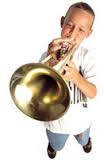Improv for Beginners
A lot of the tips that get posted on this site vary from intermediate to advanced concepts found in improvisation. While there are a few focused on beginners, I thought it would be good to post a few more to help those that are just starting out. If you are one of those that beginning improvisation is where you are at now, I would encourage you to go check out the category (For Beginners) to see some of the other posts in addition to the one below.
One of the big concerns I have heard from beginning improv students (and teachers of those students) is where do I begin? There is so much information out there it can be hard to find a good starting point. Do we start with scales? Theory? Transcribing? Let me give you my suggestion for where a beginner should start:
- Rhythm/Time
- Listening
Everything else you can work on, in my opinion, supplements those first two items. Here’s why: To have the proper sound, feel and phrasing you must have good rhythm/time. To have good rhythm/time you have to understand what is considered good by listening. #2 is something everyone should be doing already. Listen to your favorite players (old and new) and get their sound, phrasing, rhythm/time, articulation, use of space and ideas in your ear. Close your eyes and picture yourself there with them. How much should you listen? A lot. As a beginner what you listen to can help shape who you are as a musician and WILL eventually come out. Who you become as a musician is a combination of all the influences you have stored in your head.
#1 is something that can develop over time by listening AND playing rhythmic exercises. The exercise below is one that I like to use with beginners. This is also mentioned in my book Breaking the Monotony. Unless the beginner already has a pretty good sense of rhythm/time, they need to be exposed to good Jazz rhythms. This exercise takes a rhythmic example that the student plays while using any combination of the three notes listed.
Rhythm to be used:
Note choices:
Example of what this would look like over a simple Bb blues:
You can get into the theory later, but I find it is best when talking about notes to limit a beginner to 3 or 4 to start. Let them find out the different variations of what you can do with those notes on their own. Eventually they will become bored with those and will naturally want to expand their palette (although I have heard plenty of Jazz Giants do more with 3 or 4 notes then some do with all 12).
In my opinion, this is the best way to start beginners. This gets them started playing something and using their ears and rhythm to come up with ideas. As I mentioned at the top of this post, be sure to check out some of the other posts in the For Beginners category. In addition to those posts are my books you can find in my Digital Store as well as the Skype lessons/coaching I offer for all levels of players.





